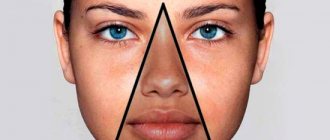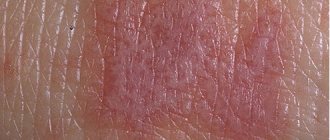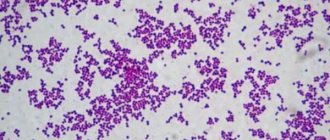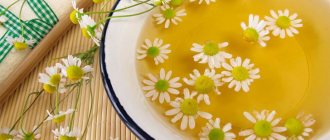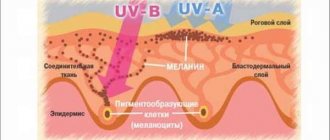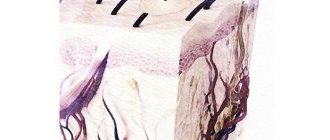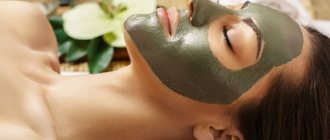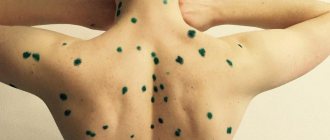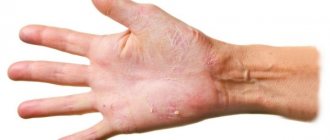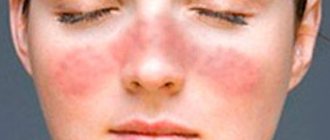1. Rectum. On the face it is represented by a projection zone on the surface of the skin of the upper left forehead. Functional impairment can manifest itself as skin pigmentation, acne, redness, and the growth of moles.
2. Sigmoid colon. Its representation is located on the surface of the skin of the left upper lateral area of the forehead. Functional impairment can manifest itself as skin pigmentation, pimples, redness, and moles.
3. Liver. The representation is located between the eyebrows, in the space between the base of the bridge of the nose and the line connecting the brow ridges on the skin of the forehead. Liver pathology is accompanied by skin irritation, acne, pigmentation, and moles.
4. Small intestine. Its projection is located in the middle part of the forehead, and with intestinal pathology it is manifested by skin disorders (pigments, pimples, redness).
5. Descending part of the colon. Its representation is located on the left lateral surface of the skin of the forehead. Functional disorders manifest themselves on the skin (pigmentation, dryness of the area, increased porosity, acne).
6. Left adrenal gland. The projection is located in the medial superciliary region of the left half of the face. With a functional disorder of the adrenal gland, pain in the periosteum of the superciliary region appears, and the skin reacts with irritation.
7. Area of the left kidney pelvis. It is projected onto the skin of the inner surface of the corner of the left eye and the tear duct. The pathological process in the area of the renal pelvis is sometimes expressed by a skin reaction in this area (darkening, pigmentation, redness, enlarged pores, growth of papillomas, wen). Sometimes the problem contributes to the formation of a blockage of the tear duct, an inflammatory process in it, and excessive lacrimation.
8. Upper pole of the left kidney. It is projected onto the brow ridge and the skin of the upper part of the eyelid. The disorder is manifested by a vascular pattern (swelling), pimples, redness, and porosity on the skin.
9. Left lobe of the liver. Projected onto the white membrane of the eye. A disorder in the liver is manifested by a red vascular pattern on the white of the eye.
10. Body of the gallbladder, spleen. The projection is located on the skin and on the periosteum of the temporal bone on the left side of the face. With bladder pathology, redness, pimples, pigment spots appear on the skin, its porosity and venous pattern increase. The periosteum of the temporal bone also reacts; it becomes painful upon palpation.
11. Left part of the transverse colon. The representation is located in the lower medial part of the corner of the left eye. Its dysfunction is manifested by bulging of the skin from the inner corner of the eye under the lower eyelid to the outside of the face, sometimes with redness or pigmentation.
12. Pancreas. Its representation is located on the lower part of the bridge of the nose, at the border of the connection with the tip of the nose. The pathology is manifested by skin irritation, pigmentation, and sometimes a venous vascular pattern.
13. Biliary ducts of the liver and gallbladder. The projection is located in the lower part of the temporal bone of the left half of the face. With their pathology, redness, pigmentation, pimples and a vascular pattern are observed on the skin, with long-term pathology - porosity. The periosteum of the temporal region becomes painful. Often the pathology is accompanied by headaches of temporal localization. Additionally, it can be noted that sometimes when the bile ducts are blocked, the skin of this area of the face turns yellow.
14. Left kidney. The projection is represented by the left auricle (skin and cartilaginous base). The auditory canal is a projection of the ureter, the inner ear is a projection of the bladder. In pathological conditions of the kidney, hearing decreases, inflammation of the inner ear occurs, and vestibular disorders appear. In some cases, hardening of the cartilage base is observed. Sometimes it softens, and sulfur secretion from the ear canal increases.
15. Cardiac pathologies. The projection is presented in the upper left part of the left cheek at the junction with the orbit. Pathologies are expressed by swelling of the skin, redness, pigmentation, and a vascular pattern in the infraorbital region.
16. Ureter of the left kidney. It is projected onto the skin of the face by a line running from the corner of the eye along the cheek to the bottom of the chin. When it is irritated by sand, small stones or when there is inflammation in it, a pattern of a line or part of a line of white or red color appears on the skin (depending on which part of the autonomic nervous system prevails - sympathetic or parasympathetic).
17. Left lobe of the liver. Its representation is located on the left side of the face, in the area of the muscles of the jaw joint. It manifests itself as an involuntary increased tone of the muscle group and the development of arthrosis of the joint. Occasionally, the disorder is projected onto the skin in the form of pigment or irritation.
18. Left mammary gland. The projection is located on the skin of the left cheek at the intersection of a vertical line coming from the outer part of the corner of the eye and a horizontal line passing through the upper pole of the wings of the nose. The diameter of the projection of the mammary gland on the cheek will be approximately equal to the distance from the corner of the eye to its iris. The pathology is manifested by pigmentation, redness, increased porosity, and swelling of the skin.
19. Left lung. It is projected onto the skin of the left cheek, covering the cheekbone. The pathology may manifest itself as redness, an angiopathic pattern, porosity, pigmentation, pimples, dryness, unevenness or roughness of the skin surface.
20. Cardiac disorders (more often - rhythm disturbances). They are projected on the skin of the tip of the nose in the form of redness, angiopathy, and pimples.
21. Bronchus of the left lung. Projected on the skin of the wing of the left half of the nose. Violations are expressed by a vascular pattern, redness, pimples, and pigmentation.
22. Diaphragm, costal arch. They are projected on the skin along the nasolabial fold. Violations are manifested by redness of the fold, dry skin in it.
23. Lesser curvature of the stomach. Projected onto the skin and mucous membrane of the upper lip. The pathology is manifested by transverse cracks on the lip, herpetic eruptions, peeling of the skin, loss of lip color, and the appearance of lip wrinkling.
24. Duodenal bulb, pyloric section of the stomach. The projection zone is located on the skin outside the corner of the mouth. Disturbances are manifested by pigmentation, redness of the skin, jams and cracks in the corners of the mouth, and in degenerative processes - the growth of moles.
25. Adrenal gland of the left kidney. It is projected onto the skin and muscles of the upper compartment on the left lateral axillary line, as well as to the left and right of it along the muscular lateral surface. The pathology is manifested by muscle pain upon palpation; on the skin it sometimes manifests itself as irritation, pigmentation, and papillomomatosis.
26. Left inguinal fold and area of the pupart ligament. The projection is located on the left outer surface of the skin of the chin. Violations are manifested by redness of the skin, acne, age spots.
27. Left ovary in women, left testicle in men. The representation is located on the skin of the chin on the left side, near the left mental fold. The pathology is manifested by redness of the skin, pimples, dryness and flaking of the skin, and the growth of moles during degenerative processes.
Special triangle
The area of the nasolabial triangle requires sufficient attention and careful treatment, because:
- In this area on the face there are especially many blood vessels.
- The veins located in this area do not have valves; accordingly, infectious agents can even penetrate into the brain through them. That is why doctors strongly do not recommend squeezing out acne in such an area.
- By the color and condition of the nasolabial triangle, one can judge the presence of some disturbances in the functioning of the body. A change in the normal color of the skin in this area helps to detect in time quite serious diseases in a child and even in adults who are still asymptomatic.
Of course, a change in the condition of the skin on the face cannot be considered as a 100% symptom of one or another health disorder. Only a doctor can make an accurate diagnosis, focusing on other signs of the disease and data from studies performed.
White nasolabial triangle
Quite often the skin on the face looks different in color. And if the area of the nasolabial triangle noticeably stands out on the face, becoming pale or blue, this is a serious reason to take a closer look at your health. So, such a pathology may indicate:
- For various disturbances in the activity of the heart. In particular, in many children, pallor or blueness of the nasolabial triangle becomes the first manifestation of congenital heart disease (of course, we are not talking about serious illnesses that can be easily diagnosed soon after birth). A white nasolabial triangle in an adult may be a sign of heart failure.
- For insufficiently good functioning of blood vessels, for example, for the presence of spasms, atherosclerosis, disorders of elasticity, strength, etc.
- On the active development of certain diseases associated with the functioning of the respiratory system. Doctors note that the nasolabial triangle often turns pale or blue with bronchitis, pneumonia, severe inflammation of the adenoids, bronchial asthma and respiratory failure.
- The development of anemia, in which the volume of hemoglobin in the body decreases and the cells receive less oxygen.
Sometimes the appearance of a white circle or triangle around the mouth is associated with a local disturbance of blood flow in small subcutaneous vessels. This situation can be completely normal if a person goes outside into the cold or is very worried.
Natalia Gaydash
dermatocosmetologist, candidate of medical sciences, head of the aesthetic medicine clinic “TriActive”
When patients “prescribe” themselves drugs such as “Claritin”, “Fenkarol”, “Gistalong”, for example, for contact dermatitis, this does not bring any clinical effect. Self-prescription of medications, especially steroids, for the treatment of dermatitis can end very sadly, even if we are talking only about external therapy. I know cases where patients with mild dermatitis, which could go away on their own after limiting contact with an irritating substance, “prescribed” themselves very strong ointments that caused serious disturbances in the structure of the skin. Such self-medication is especially dangerous when it comes to facial skin.
Red nasolabial triangle
Sometimes the color of the skin in the area of the nasolabial triangle changes to the red side, which can also be a rather serious symptom and indicate:
- Development of various allergic reactions. Unexpected symptoms of individual intolerance may appear when the skin is directly affected by allergens (cosmetics, drugs, herbs, etc.), as well as with systemic allergies (to wool, food, medications, etc.). Hyperemia in this case is often accompanied by unpleasant itching and flaking; reddish skin may become covered with rashes. It is also possible to experience an allergic runny nose, watery eyes, sneezing, etc.
- Perioral dermatitis. In principle, this condition is a type of allergic reaction, but it is typically precisely located in the area of the nasolabial triangle (and near the mouth, in particular). With the development of perioral dermatitis, the skin first turns red, irritation occurs on it, and then it is covered with a small and frequent pustular rash. Most often, this problem occurs in adults - young girls and mature women. Some doctors suggest that the occurrence of perioral dermatitis may be associated with certain components of cosmetic products. A new toothpaste can also contribute to its appearance.
- Demodecosis. This disease occurs due to the aggression of a microscopic parasite – the Demodex mite. It can live quietly on the skin for many years, but under the influence of provoking factors (decreased immunity, hormonal fluctuations, etc.) it begins to actively multiply and provokes inflammation, acne and other problems. Most often, demodicosis begins with redness of the nose and nasolabial triangle, after which it progresses and spreads to the cheeks.
- Other dermatological diseases. In particular, the skin in the area of the nasolabial triangle may turn red and become covered with rashes due to streptoderma (in this case, a weeping rash or crater spots are visible to the naked eye), fungal diseases, etc.
As a rule, the nasolabial triangle in children turns red in response to various allergic reactions. Subsequently, the redness may be accompanied by a rash and peeling.
Varieties
There are different types of acne on the nasolabial folds:
Comedones. These are small black dots. They appear due to increased activity of the sebaceous glands when the pores become clogged. Over time, sebum oxidizes and turns black. Comedones can be closed or open.
- Papules. Small blackheads with a white head that cause pain when pressed.
- Pustules. Medium-sized purulent rashes. They manifest themselves as painful sensations, itching and redness. To remove them, pulling agents or mechanical cleaning are used. Traces may remain after the pustule.
- Cystic acne. This is a severe form of rash in the form of large cysts. The formations are dense, painful, and very itchy. After the rash disappears, scars remain.
- Lightning rash. The rash appears due to a sudden decrease in immunity. Such acne is accompanied by fever and weakness.
READ ALSO: How to get rid of acne on the back, shoulders, chest, quickly at home
Return to contents
Numbness of the nasolabial triangle
The unpleasant feeling of numbness is not just uncomfortable. Its occurrence in the area of the lips and nose can warn of:
- Cervical osteochondrosis. This pathology can also manifest itself as frequent headaches, excessive fatigue, and pain when moving the neck.
- Lack of B vitamins. Also, such a disorder often leads to excessive fatigue, memory impairment, lack of concentration, sleep problems, etc.
- Bell's palsy or facial neuritis. This pathology is difficult to ignore, as it causes pain behind the ears, prevents the eyelids from closing fully and causes visually noticeable asymmetry of the face.
- Neurosis, depression or vegetative-vascular dystonia.
One-time numbness is not a reason to immediately run to the doctor. But if such a symptom bothers you from time to time, and even more so is complemented by other health problems, it is better to play it safe and undergo a full examination.
Redness and peeling of the skin on the face is evidence of disease or a sign of a functional disorder of individual systems and organs on which the condition of the skin depends. In most cases, these manifestations are accompanied by pain and discomfort, especially if patients experience skin rashes, inflammation, peeling and itching. To eliminate this problem, it is necessary to accurately determine the cause of its occurrence. In most cases, this requires diagnostic measures.
Localization and prevalence
Perioral dermatitis is localized on the face, in the area of the nasolabial triangle (chin, nose, skin around the lips). In this case, there is a thin strip of healthy skin directly next to the oral cavity. In rare cases, changes affect the neck, forehead and area around the eyes (periorbital dermatitis).
This problem affects 1% of the world's inhabitants. As we have already said, most patients are women of reproductive age; very rarely the disease affects men.
How to get rid of congestion on lips
To clear plaque, experts recommend acting in several directions at once - regularly treating the oral cavity, as well as eliminating the cause of the phenomenon. Standard measures include the following manipulations:
- normalization of diet, restoration of drinking regime,
- taking multivitamin complexes and immunomodulating drugs,
- antiviral and antifungal therapy,
- rinsing the mouth with decoctions of medicinal herbs and soda solution,
- regular cleaning of the mouth with soft brushes or treating problem areas with a cotton swab dipped in a special solution or essential oils that promote tissue healing.
Perioral dermatitis in children
Recently, cases of perioral skin inflammation in young patients have become more frequent. This is mainly due to long-term treatment with moderate to strong corticosteroids (eg, Lorindene, Flucinar, Dermovate, etc.). The side effect occurs due to the uncontrolled use of such drugs without the knowledge of the doctor for several months or even years.
Perioral dermatitis in children
Often, perioral dermatitis is associated with teething in a child, diathesis and allergic reactions. The fight against this disease should only be done under the supervision of a specialist in combination with general therapy. With age, the problem may disappear on its own.
Causes of perioral dermatitis
- It is believed that the inflammatory process around the mouth is caused by certain components of decorative cosmetics and frequent skin irritation.
- Excessive use of facial care products is also a common cause. Constant use of fatty creams and oils causes swelling and increases the fat content of the epidermis. The result is pimples and redness.
- The appearance of perioral dermatitis is facilitated by the abuse of toothpastes and other oral care products that contain sodium lauryl sulfate and fluoride.
- Another cause of the problem is the chronic use of topical glucocorticoid drugs.
- Hormones also play a role in the development of the disease. Therefore, patients often become women taking oral contraceptives
- Other risk factors are solar radiation, a genetic tendency to develop vasomotor reactions, and the presence of other dermatological diseases (for example, acne).
All about the causes of white plaque on the lips: how dangerous it is and how to get rid of the problem
White plaque on the lips and oral mucosa is a fairly common problem that causes aesthetic inconvenience and discomfort to a person.
Sometimes such a symptom indicates the presence of quite serious diseases. It is worth finding out the etiology of this problem, as well as methods of treatment in both adults and children. This pathology will be discussed further in the material. In some cases, the phenomenon in question appears periodically and at different times of the day. In other situations, the problem is present on an ongoing basis. For example, a person may notice plaque in the morning after sleep, during which the saliva flowing from the mouth dries, forming a whitish crust. This condition passes through a certain period and should not cause alarm.
- allergic reactions, which are caused, for example, by the use of toothpaste containing components that irritate the mucous membranes,
- vitamin deficiency associated with a lack of useful vitamins and microelements in the body - cracks appear in the corners of the lips, followed by a white coating,
- wearing uncomfortable or deformed orthopedic structures, which leads to injury to the mucous membrane and its drying out due, for example, to the inability to close the mouth normally,
- taking potent drugs, antibiotics, hormones and contraceptives, undergoing chemotherapy - all these factors can lead to changes in the composition of saliva and disruption of the protective functions of the oral mucosa,
- smoking and other bad habits - plaque in this case can be regarded as the first signal that it’s time to quit smoking and excessive alcohol consumption,
- dehydration of the body due to increased physical activity, as well as prolonged exposure to heat - dry mucous membranes lead to the appearance of small cracks around the lips and whitish discharge,
- problems with nasal breathing, due to which the mucous membrane often dries out, because you have to breathe through the mouth,
- prolonged depressive state - in such cases, the lower lip usually suffers mainly, on which, in addition to plaque, small pimples also appear. You need to reconsider your lifestyle, try to sleep at least 8 hours a day, or better yet, take a vacation from work and have a good rest, because the result of stress is not only plaque, but also other malfunctions in the internal systems of the body,
- poor nutrition, excessive consumption of salty, sweet, smoked, heavy and fatty foods, leading to problems such as dysbiosis, gastritis and other gastrointestinal disorders,
- systemic pathologies such as diabetes mellitus,
- viral and bacterial infections, which are most often caused by decreased immunity and poor oral hygiene.
If the plaque goes away after some time, then there is no need to worry
. It is worth noting that a light film may well be the result of using low-quality lipstick or gloss. Some cosmetic products add components that promote drying and peeling of the epithelium. To solve the problem, just stop using low-quality cosmetics.
Treatment of perioral dermatitis
So, you have been diagnosed with perioral dermatitis. How to treat this disease? This decision must be made by the doctor.
Therapy is difficult and lengthy. The first step is to stop taking corticosteroids - this technique is called “zero treatment”. If the cause of inflammation lies precisely in these drugs, there is a high probability that the rash will disappear spontaneously. The patient should also temporarily stop using cosmetics - lipsticks, lip balms, face creams, etc. It is recommended to carefully wash with clean water without soap.
In severe cases, the patient is prescribed oral antibiotics (such as azithromycin, erythromycin, metronidazole), vitamin A derivatives and azelaic acid. Sometimes drugs of the imizadol group (metronizadol, trichopolum) give a good effect.
Perioral dermatitis photo
To accelerate the regeneration of the epidermis and eliminate redness, mild moisturizing and anti-inflammatory agents, such as Ivostin cream, are used. In case of severe itching and irritation, general antihistamines (for example, Fenistil) are prescribed. Since Malassezia fungi can develop against the background of inflammatory lesions (which significantly complicates the healing process), the doctor may prescribe topical antifungal agents that provide a good anti-inflammatory effect (for example, Lamisilate cream). All these drugs do not belong to the group of steroids, which means they are completely safe for adult patients and children.
During the period of therapy, it is better to give up coffee, alcohol, sweet carbonated drinks, spicy and smoked foods, processed foods and fast food. Try to avoid stress and direct sunlight.
If, after recovery, the patient is concerned about aesthetic problems (spots, spider veins and scars remain on the face), it is necessary to seek the help of a cosmetologist. The specialist, based on the client’s condition, will prescribe laser procedures, liquid nitrogen treatment, electrocoagulation and other procedures.
White lips in adults and children: diagnosis and treatment
In cases where anamnesis and visual examination of the affected areas of the lips are not enough to make an accurate diagnosis, laboratory and instrumental studies are prescribed. Usually this:
- clinical blood and urine analysis;
- blood chemistry;
- microscopy of lip plaque, histological examination of the selected material;
- Ultrasound, CT, MRI - if necessary, assess the condition of internal organs.
After the diagnosis is made, measures are taken to eliminate the causes of the disease. For some, the doctor will recommend getting rid of bad habits, preventing the adverse effects of the environment, and reviewing their diet in order to saturate it with vitamins and microelements. Others will need drug therapy with systemic and local medications.
What does the formation of a whitish film mean? You can conduct preliminary diagnostics and identify the suspected cause of the problem by its location and main characteristics:
- cheilitis, herpes - clots form on the outside of the lips,
- candidiasis - accumulation on the inside of the lips in the form of a cheesy layer,
- problems of the gastrointestinal tract - clots look like a sticky film,
- vitamin deficiency, alcohol and nicotine addiction - a whitish coating collects in the corners of the mouth.
We suggest you read: Why do adults grind their teeth in their sleep at night?
Accumulations under the lip also occur with fungal infections of the mucous membrane. If they cover the palate, tonsils, the inside of the cheeks and the tongue, then this is a severe form of infection. In men, this type of formation is most often the result of smoking.
Treatment with folk remedies
Since ancient times, our ancestors fought against any rashes with the help of herbs, roots and plant seeds. They have an astringent and antibacterial effect, soothe irritation and itching, and, most importantly, do not cause side effects. You can successfully combine traditional pharmacotherapy with home techniques.
Facial lotion
Wipe your skin or wash your face with this lotion, and over time all rashes will disappear. Here is the prescription:
- 4 tablespoons dried sage;
- ¼ teaspoon of borax;
- 4 tablespoons of alcohol;
- 3 tablespoons witch hazel extract;
- 10 drops of glycerin.
Infuse the sage herb in alcohol for 2 weeks, then strain. Dissolve borax in witch hazel extract, mix with strained sage tincture, then add glycerin. Pour the lotion into the bottle and cap tightly. Shake the product before use.
Herbal mask Make herbal masks for yourself every three days. They heal affected areas much faster than pharmaceutical ointments. We give a recipe for one of the most effective masks for your illness:
- a teaspoon of chamomile flowers;
- a teaspoon of linden blossom;
- a teaspoon of lavender;
- teaspoon of sage.
Preparation: Place all ingredients in a glass or porcelain bowl and pour in a small amount of boiling water to form a thick paste. Cover the bowl and set aside for a few minutes to thoroughly wet the herbs. After this time, add a little more boiling water. Apply a warm mask to the affected areas (but you can treat the entire face - this will only bring benefits). After 20 minutes, wash with warm water.
Oils Herbalists recommend lubricating the nasolabial triangle area with natural oils 2-3 times a day. This can be sea buckthorn oil, almond oil, argan oil, flaxseed oil, peach oil, and grape seed oil. Patients notice the therapeutic effect already in the second week of regular use of this technique.
Why are wrinkles only on one side of the face?
In order for the grooves separating the cheeks and lips to become deep, several factors must influence their formation. The “culprit” may be heredity, which transmits with genes a predisposition to such a phenomenon. This is the structure of the skull with a certain location of the cheekbones, and the ability of tissues to maintain tone.
Smile is one of the provoking factors
There are other reasons for the development of wrinkles that are not related to gene memory:
- bite not corrected in time;
- constant talking while eating;
- increased facial activity;
- habit of sleeping with your face buried in the pillow;
- Factors affecting the condition of the skin can increase the depressions.
The last point includes the negative impact of climatic conditions, lack of vitamins (primarily A, E and group B). Lack of moisture intake weakens skin elasticity. But its excess also negatively affects the condition of the dermis and muscle tissue. The nasolabial triangle may swell significantly.
Against the background of bad habits (alcohol, smoking, drugs), early aging of the epidermis is observed. This also leads to the formation of deep wrinkles, as do various neurological diseases.
The problem can be prevented by taking preventive measures at a young age. Some women begin to turn to the services of mesotherapists in advance, even before the first folds and wrinkles appear. Others prefer more enjoyable activities.
Facial gymnastics
Many different exercises have been developed to maintain muscle elasticity and skin tightening. With daily exercises it is easy to avoid unsightly creases. In addition to standard gymnastics, the master can offer a woman the Carol Maggio complex, aimed at preventing aesthetic defects and rejuvenating the skin.
One of the features of this method is non-contact (only muscle-brain connection), which makes gymnastics harmless to health. The effect of exercises according to Carol Maggio is observed both with a lack of muscle tone and with its excess.
We invite you to familiarize yourself with the causes of early wrinkles and age spots
Massages
As a preventative measure, these procedures are the most effective. It is proposed to consider 2 types of effects on mimicry tissues.
Classification of nasolabial folds
Folds around the mouth appear in different ways and can be on one side, so this problem has its own classification.
Types of nasolabial folds
Fold typeFeatures
| Gradient | It can occur against the background of a difference in the heights of the cheek and upper lip. |
| Hatch | This is a thin superficial line without disturbing the subcutaneous tissue. |
| Gap | A deep wrinkle that catches the eye. Provoked by age-related changes in epidermal tissue |
The more pronounced the nasolabial folds, the older the woman looks. This problem does not affect your health, but a cosmetic defect can significantly spoil your mood. An early visit to a specialist will allow you to more effectively correct your appearance.
Correction of nasolabial folds
If nasolabial folds have suddenly appeared or have been bothering you for several years, it is worth visiting a beauty salon. Having determined the degree of the defect and the cause of its occurrence, the specialist will suggest one of the available methods to eliminate it.
Salon correction of nasolabial folds
ProcedureFeatures
| Lipofilling | The procedure is performed in a hospital setting and involves pumping fat tissue into the folds and wrinkles of the face. The material is taken from other areas of the body where excess has accumulated (hips, waist). This method does not provoke allergies, the result is visible immediately and is designed for a long period |
| Hyaluronic acid | • Using a special device, the product is injected into the nasolabial folds using local anesthesia. This allows you to replenish the volume of tissue, making the face smoother;• There are no scars left on the skin, but swelling lasts for several days. Correction with filler is harmless, the duration of the effect (6-12 months) depends on the skin turgor and the density of the filler |
| Botox | • Radical impact on the nasolabial folds is carried out using injections of a neurotoxic drug. Thanks to it, nerve impulses transmitted along muscle fibers are blocked. This leads to relaxation of the facial muscles, smoothing out folds and wrinkles; • How long the effect will last (4 months or a year) depends on the amount of filler used. Botox is eliminated from the body on its own, and after its effect ends, the folds may increase, which will require repeated correction;• It is better to entrust the procedure to an experienced specialist to avoid displacement of the drug and disruption of facial expressions |
| Peeling | • A deep invasion of the epidermis is carried out - you will need to remove the entire top layer of skin. The procedure starts the regeneration process in tissues, which leads to facial rejuvenation and smoothing out wrinkles. Pores are narrowed, pigmentation and scars are removed; • Side effects of the procedure are redness and swelling, which last for about a week. For the first six months after the session, you cannot visit the sauna, solarium, expose your face to the sun, or engage in physical activity. |
Important! Deep peeling is not recommended for everyone - pregnant women, breastfeeding women, people suffering from somatic diseases and having problems with blood clotting are at risk. Even the slightest pimple can be a contraindication for any of the procedures.
We invite you to familiarize yourself with folk methods of removing wrinkles
Correction with fillers
In addition to hyaluronic acid, other filler substances are used to correct nasolabial folds: collagen, silicone, bioceramics. Each of them has a narrowly targeted effect, therefore, which filler to choose is determined by a specialist.
The dosage of administered drugs is selected individually. In this case, the woman’s age, the severity of folds, and facial structure features are taken into account.
Recommendations for facial care
Properly selected beauty care products will prevent wrinkles from forming and will help get rid of nasolabial folds if they suddenly begin to appear.
Home treatments are an excellent way to avoid premature aging and eliminate the bulldog sign on the face. Below are the recipes most recommended by cosmetologists.
Healing compounds
NameRecommendations for use
| Gelatinous | Helps maintain tissue elasticity and normalize muscle tone. The product is prepared in this way: • gelatin (1 tbsp) is diluted in water at room temperature (1/4 cup) and left for 30 minutes; • compressed spirulina algae (4 tablets) is moistened with water and kneaded; • both products are combined; • add vitamin A (1 capsule) and lemon juice (2-3 drops); • leave for another half hour and the composition is applied to gauze. Keep the mask on the face for 20 minutes, then wash off with warm water. It is advisable to use the product twice a week for 14 days |
| With cosmetic clay | Suitable for all ages, but for aging mature skin it is recommended to choose pink and green clay. To dilute the powder, use decoctions of herbs (St. John's wort, coltsfoot, mint, chamomile, string, sage, birch buds). Additional elements that enhance the effect will be argan, grape seed, coconut, and peach oils. It is recommended to apply the creamy mass to the face every 2 days. |
Clay rejuvenating mask
A fish oil mask has an excellent effect. This product is a good source of omega-3 polyunsaturated fats and vitamin D. To create a nutritional composition, the same amount of olive oil and a little starch are added to fish oil.
Exposure to heat
Enlargement of the hollow in the lip area can be prevented by periodically applying heat compresses using medicinal infusions:
- prepare a collection from the herbs mentioned above; components are taken at your own discretion;
- pour boiling water over it and leave;
- moisten pieces of gauze (bandage) with warm liquid;
- Apply to the nasolabial area of the face (on each side) and hold for 15 minutes.
Note! To increase the effect, it is advisable to apply the compress daily before bed. This stimulates the production of collagen in tissues.
Swelling of the nasolabial fold will help remove the ice. The cubes are prepared from herbal decoctions, freshly squeezed juices of vegetables, fruits and berries. It is enough to wipe the skin on your face with pieces of ice every day to speed up the restoration processes in the dermis and launch protective mechanisms.
The described methods of getting rid of an unsightly defect are recommended not only for women; men who care about their appearance can also use the advice.
Source: https://multiorganic.ru/pochemu-morshchiny-tolko-odnoy-storony-litsa/
Prevention of perioral dermatitis
To prevent recurrence of pathology, it is necessary to use local corticosteroid ointments with caution. Do not exceed the duration of their use and dosage, but it is best to completely abandon such drugs.
People with increased vasomotor sensitivity should sunbathe moderately and avoid saunas and hot baths. It is best to wash your face with soft gels that do not contain sodium lauryl sulfate. Choose organic, fluoride-free toothpastes. After washing, it is necessary to lubricate the skin with creams with a light texture (without overusing cosmetics).
